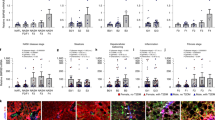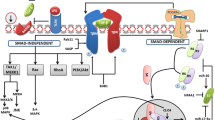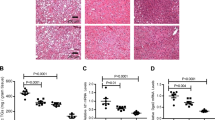Abstract
Bone morphogenetic protein 9 (BMP9) is a recently discovered cytokine mainly secreted by the liver and is a member of the transforming growth factor β (TGF-β) superfamily. In recent years, an increasing number of studies have shown that BMP9 is associated with liver diseases, including nonalcoholic fatty liver disease (NAFLD), liver fibrosis and hepatocellular carcinoma (HCC), and BMP9 signaling may play dual roles in liver diseases. In this review, we mainly summarized and discussed the roles and potential mechanisms of BMP9 signaling in NAFLD, liver fibrosis and HCC. Specifically, this article will provide a better understanding of BMP9 signaling and new clues for the treatment of liver diseases.



Similar content being viewed by others
References
Bragdon B, Moseychuk O, Saldanha S, King D, Julian J, Nohe A (2011) Bone morphogenetic proteins: a critical review. Cell Signal 23(4):609–620. https://doi.org/10.1016/j.cellsig.2010.10.003
Kim M, Choe S (2011) BMPs and their clinical potentials. BMB Rep 44(10):619–634. https://doi.org/10.5483/BMBRep.2011.44.10.619
Sanchez-Duffhues G, Hiepen C, Knaus P, Ten Dijke P (2015) Bone morphogenetic protein signaling in bone homeostasis. Bone 80:43–59. https://doi.org/10.1016/j.bone.2015.05.025
Hiepen C, Yadin D, Rikeit P, Dörpholz G, Knaus P (2016) Actions from head to toe: an update on bone/body morphogenetic proteins in health and disease. Cytsokine Growth Factor Rev 27:1–11. https://doi.org/10.1016/j.cytogfr.2015.12.006
Miller AF, Harvey SAK, Thies RS, Olson MS (2000) Bone morphogenetic protein-9. An autocrine/paracrine cytokine in the liver. J Biol Chem 275(24):17937–17945. https://doi.org/10.1074/jbc.275.24.17937
Bidart M, Ricard N, Levet S, Samson M, Mallet C, David L et al (2012) BMP9 is produced by hepatocytes and circulates mainly in an active mature form complexed to its prodomain. Cell Mol Life Sci 69(2):313–324. https://doi.org/10.1007/s00018-011-0751-1
Ploemacher RE, Engels LJ, Mayer AE, Thies S, Neben S (1999) Bone morphogenetic protein 9 is a potent synergistic factor for murine hemopoietic progenitor cell generation and colony formation in serum-free cultures. Leukemia 13(3):428–437. https://doi.org/10.1038/sj.leu.2401363
Kang Q, Sun MH, Cheng H, Peng Y, Montag AG, Deyrup AT et al (2004) Characterization of the distinct orthotopic bone-forming activity of 14 BMPs using recombinant adenovirus-mediated gene delivery. Gene Ther 11(17):1312–1320. https://doi.org/10.1038/sj.gt.3302298
Yang M, Liang Z, Yang M, Jia Y, Yang G, He Y et al (2019) Role of bone morphogenetic protein-9 in the regulation of glucose and lipid metabolism. FASEB J 33(9):10077–10088. https://doi.org/10.1096/fj.201802544RR
Truksa J, Peng H, Lee P, Beutler E (2006) Bone morphogenetic proteins 2, 4, and 9 stimulate murine hepcidin 1 expression independently of Hfe, transferrin receptor 2 (Tfr2), and IL-6. Proc Natl Acad Sci U S A 103(27):10289–10293. https://doi.org/10.1073/pnas.0603124103
Schnitzler AC, Mellott TJ, Lopez-Coviella I, Tallini YN, Kotlikoff MI, Follettie MT et al (2010) BMP9 (bone morphogenetic protein 9) induces NGF as an autocrine/paracrine cholinergic trophic factor in developing basal forebrain neurons. J Neurosci 30(24):8221–8228. https://doi.org/10.1523/jneurosci.5611-09.2010
Garcia de Vinuesa A, Abdelilah-Seyfried S, Knaus P, Zwijsen A, Bailly S (2016) BMP signaling in vascular biology and dysfunction. Cytokine Growth Factor Rev 27:65–79. https://doi.org/10.1016/j.cytogfr.2015.12.005
Yoshimatsu Y, Lee YG, Akatsu Y, Taguchi L, Suzuki HI, Cunha SI et al (2013) Bone morphogenetic protein-9 inhibits lymphatic vessel formation via activin receptor-like kinase 1 during development and cancer progression. Proc Natl Acad Sci U S A 110(47):18940–18945. https://doi.org/10.1073/pnas.1310479110
Breitkopf-Heinlein K, Meyer C, Konig C, Gaitantzi H, Addante A, Thomas M et al (2017) BMP-9 interferes with liver regeneration and promotes liver fibrosis. Gut 66(5):939–954. https://doi.org/10.1136/gutjnl-2016-313314
Li P, Li Y, Zhu L, Yang Z, He J, Wang L et al (2018) Targeting secreted cytokine BMP9 gates the attenuation of hepatic fibrosis. Biochim Biophys Acta Mol Basis Dis 1864(3):709–720. https://doi.org/10.1016/j.bbadis.2017.12.008
Brown MA, Zhao Q, Baker KA, Naik C, Chen C, Pukac L et al (2005) Crystal structure of BMP-9 and functional interactions with pro-region and receptors. J Biol Chem 280(26):25111–25118. https://doi.org/10.1074/jbc.M503328200
Yadin D, Knaus P, Mueller TD (2016) Structural insights into BMP receptors: specificity, activation and inhibition. Cytokine Growth Factor Rev 27:13–34. https://doi.org/10.1016/j.cytogfr.2015.11.005
Nickel J, Mueller TD (2019) Specification of BMP Signaling. Cells 8(12):1579. https://doi.org/10.3390/cells8121579
Lawera A, Tong Z, Thorikay M, Redgrave RE, Cai J, Mv D et al (2019) Role of soluble endoglin in BMP9 signaling. Proc Natl Acad Sci U S A 116(36):17800–17808. https://doi.org/10.1073/pnas.1816661116
David L, Mallet C, Mazerbourg S, Feige JJ, Bailly S (2007) Identification of BMP9 and BMP10 as functional activators of the orphan activin receptor-like kinase 1 (ALK1) in endothelial cells. Blood 109(5):1953–1961. https://doi.org/10.1182/blood-2006-07-034124
Herrera B, van Dinther M, Ten Dijke P, Inman GJ (2009) Autocrine bone morphogenetic protein-9 signals through activin receptor-like kinase-2/Smad1/Smad4 to promote ovarian cancer cell proliferation. Cancer Res 69(24):9254–9262. https://doi.org/10.1158/0008-5472.can-09-2912
Herrera B, Dooley S, Breitkopf-Heinlein K (2014) Potential roles of bone morphogenetic protein (BMP)-9 in human liver diseases. Int J Mol Sci 15(4):5199–5220. https://doi.org/10.3390/ijms15045199
Star GP, Giovinazzo M, Langleben D (2010) Bone morphogenic protein-9 stimulates endothelin-1 release from human pulmonary microvascular endothelial cells: a potential mechanism for elevated ET-1 levels in pulmonary arterial hypertension. Microvasc Res 80(3):349–354. https://doi.org/10.1016/j.mvr.2010.05.010
Scharpfenecker M, van Dinther M, Liu Z, van Bezooijen RL, Zhao Q, Pukac L et al (2007) BMP-9 signals via ALK1 and inhibits bFGF-induced endothelial cell proliferation and VEGF-stimulated angiogenesis. J Cell Sci 120(6):964–972. https://doi.org/10.1242/jcs.002949
Herrera B, Sánchez A, Fabregat I (2012) BMPS and liver: more questions than answers. Curr Pharm Des 18(27):4114–4125. https://doi.org/10.2174/138161212802430503
Xu DJ, Zhao YZ, Wang J, He JW, Weng YG, Luo JY (2012) Smads, p38 and ERK1/2 are involved in BMP9-induced osteogenic differentiation of C3H10T1/2 mesenchymal stem cells. BMB Rep 45(4):247–252. https://doi.org/10.5483/bmbrep.2012.45.4.247
Zhao Y, Song T, Wang W, Wang J, He J, Wu N et al (2012) P38 and ERK1/2 MAPKs act in opposition to regulate BMP9-induced osteogenic differentiation of mesenchymal progenitor cells. PLoS ONE 7(8):e43383. https://doi.org/10.1371/journal.pone.0043383
Zhao YF, Xu J, Wang WJ, Wang J, He JW, Li L et al (2013) Activation of JNKs is essential for BMP9-induced osteogenic differentiation of mesenchymal stem cells. BMB Rep 46(8):422–427. https://doi.org/10.5483/bmbrep.2013.46.8.266
Younossi ZM (2019) Non-alcoholic fatty liver disease—A global public health perspective. J Hepatol 70(3):531–544. https://doi.org/10.1016/j.jhep.2018.10.033
Eslam M, Newsome PN, Sarin SK, Anstee QM, Targher G, Romero-Gomez M et al (2020) A new definition for metabolic dysfunction-associated fatty liver disease: an international expert consensus statement. J Hepatol 73(1):202–209. https://doi.org/10.1016/j.jhep.2020.03.039
Eslam M, Sanyal AJ, George J, International Consensus P (2020) MAFLD: a consensus-driven proposed nomenclature for metabolic associated fatty liver disease. Gastroenterology 158(7):1999–2014. https://doi.org/10.1053/j.gastro.2019.11.312
Younossi Z, Tacke F, Arrese M, Chander Sharma B, Mostafa I, Bugianesi E et al (2019) Global perspectives on nonalcoholic fatty liver disease and nonalcoholic steatohepatitis. Hepatology 69(6):2672–2682. https://doi.org/10.1002/hep.30251
Takaki A, Kawai D, Yamamoto K (2013) Multiple hits, including oxidative stress, as pathogenesis and treatment target in non-alcoholic steatohepatitis (NASH). Int J Mol Sci 14(10):20704–20728. https://doi.org/10.3390/ijms141020704
Friedman SL, Neuschwander-Tetri BA, Rinella M, Sanyal AJ (2018) Mechanisms of NAFLD development and therapeutic strategies. Nat Med 24(7):908–922. https://doi.org/10.1038/s41591-018-0104-9
Jia Y, Niu D, Li Q, Huang H, Li X, Li K et al (2019) Effective gene delivery of shBMP-9 using polyethyleneimine-based core-shell nanoparticles in an animal model of insulin resistance. Nanoscale 11(4):2008–2016. https://doi.org/10.1039/c8nr08193j
Chen C, Grzegorzewski KJ, Barash S, Zhao Q, Schneider H, Wang Q et al (2003) An integrated functional genomics screening program reveals a role for BMP-9 in glucose homeostasis. Nat Biotechnol 21(3):294–301. https://doi.org/10.1038/nbt795
Caperuto LC, Anhe GF, Cambiaghi TD, Akamine EH, Do Carmo Buonfiglio D, Cipolla-Neto J et al (2008) Modulation of bone morphogenetic protein-9 expression and processing by insulin, glucose, and glucocorticoids: possible candidate for hepatic insulin-sensitizing substance. Endocrinology 149(12):6326–6335. https://doi.org/10.1210/en.2008-0655
Anhê FF, Lellis-Santos C, Leite AR, Hirabara SM, Boschero AC, Curi R et al (2010) Smad5 regulates Akt2 expression and insulin-induced glucose uptake in L6 myotubes. Mol Cell Endocrinol 319(1–2):30–38. https://doi.org/10.1016/j.mce.2010.01.003
Luo Y, Li L, Xu X, Wu T, Yang M, Zhang C et al (2017) Decreased circulating BMP-9 levels in patients with type 2 diabetes is a signature of insulin resistance. Clin Sci 131(3):239–246. https://doi.org/10.1042/CS20160543
Xu X, Li X, Yang G, Li L, Hu W, Zhang L et al (2017) Circulating bone morphogenetic protein-9 in relation to metabolic syndrome and insulin resistance. Sci Rep 7(1):17529. https://doi.org/10.1038/s41598-017-17807-y
Huang H, Wang W, Yang G, Zhang Y, Li X, Liu H et al (2018) Circulating bone morphogenetic protein-9 levels are associated with hypertension and insulin resistance in humans. J Am Soc Hypertens 12(5):372–380. https://doi.org/10.1016/j.jash.2018.02.007
Morioka T, Emoto M, Yamazaki Y, Kurajoh M, Motoyama K, Mori K et al (2018) Plasma soluble leptin receptor levels are associated with pancreatic β-cell dysfunction in patients with type 2 diabetes. J Diabetes Investig 9(1):55–62. https://doi.org/10.1111/jdi.12657
Cristancho AG, Lazar MA (2011) Forming functional fat: a growing understanding of adipocyte differentiation. Nat Rev Mol Cell Biol 12(11):722–734. https://doi.org/10.1038/nrm3198
Kahn SE, Hull RL, Utzschneider KM (2006) Mechanisms linking obesity to insulin resistance and type 2 diabetes. Nature 444(7121):840–846. https://doi.org/10.1038/nature05482
Saltiel AR, Olefsky JM (2017) Inflammatory mechanisms linking obesity and metabolic disease. J Clin Invest 127(1):1–4. https://doi.org/10.1172/jci92035
Poher AL, Altirriba J, Veyrat-Durebex C, Rohner-Jeanrenaud F (2015) Brown adipose tissue activity as a target for the treatment of obesity/insulin resistance. Front Physiol 6:4. https://doi.org/10.3389/fphys.2015.00004
Kuo MM, Kim S, Tseng CY, Jeon YH, Choe S, Lee DK (2014) BMP-9 as a potent brown adipogenic inducer with anti-obesity capacity. Biomaterials 35(10):3172–3179. https://doi.org/10.1016/j.biomaterials.2013.12.063
Kim S, Choe S (1862) Lee DK (2016) BMP-9 enhances fibroblast growth factor 21 expression and suppresses obesity. Biochim Biophys Acta 7:1237–1246. https://doi.org/10.1016/j.bbadis.2016.04.006
Yang Z, Li P, Shang Q, Wang Y, He J, Ge S et al (2020) CRISPR-mediated BMP9 ablation promotes liver steatosis via the down-regulation of PPARa expression. Sci Adv 6(48):eabc5022. https://doi.org/10.1126/sciadv.abc5022
Sun QJ, Cai LY, Jian J, Cui YL, Huang CK, Liu SQ et al (2021) The Role of bone morphogenetic protein 9 in nonalcoholic fatty liver disease in mice. Front Pharmacol 11:605967. https://doi.org/10.3389/fphar.2020.605967
Li Q, Liu B, Breitkopf-Heinlein K, Weng H, Jiang Q, Dong P et al (2019) Adenovirus-mediated overexpression of bone morphogenetic protein-9 promotes methionine choline deficiency-induced no-nalcoholic steatohepatitis in non-obese mice. Mol Med Rep 20(3):2743–2753. https://doi.org/10.3892/mmr.2019.10508
Gaitantzi H, Karch J, Germann L, Cai C, Rausch V, Birgin E et al (2020) BMP-9 modulates the hepatic responses to LPS. Cells 9(3):617. https://doi.org/10.3390/cells9030617
Hernandez-Gea V, Friedman SL (2011) Pathogenesis of liver fibrosis. Annu Rev Pathol 6:425–456. https://doi.org/10.1146/annurev-pathol-011110-130246
Tacke F, Trautwein C (2015) Mechanisms of liver fibrosis resolution. J Hepatol 63(4):1038–1039. https://doi.org/10.1016/j.jhep.2015.03.039
Higashi T, Friedman SL, Hoshida Y (2017) Hepatic stellate cells as key target in liver fibrosis. Adv Drug Deliv Rev 121:27–42. https://doi.org/10.1016/j.addr.2017.05.007
Lee YA, Wallace MC, Friedman SL (2015) Pathobiology of liver fibrosis: a translational success story. Gut 64(5):830–841. https://doi.org/10.1136/gutjnl-2014-306842
Fabre T, Molina MF (2018) Type 3 cytokines IL-17A and IL-22 drive TGF-β-dependent liver fibrosis. Sci Immunol 3(28):7754. https://doi.org/10.1126/sciimmunol.aar7754
Schuppan D, Ashfaq-Khan M, Yang AT, Kim YO (2018) Liver fibrosis: direct antifibrotic agents and targeted therapies. Matrix Biol 68–69:435–451. https://doi.org/10.1016/j.matbio.2018.04.006
Dewidar B, Meyer C, Dooley S, Meindl-Beinker AN (2019) TGF-β in hepatic stellate cell activation and liver fibrogenesis-updated 2019. Cells 8(11):1419. https://doi.org/10.3390/cells8111419
Herrera B, Addante A, Sanchez A (2017) BMP signalling at the crossroad of liver fibrosis and regeneration. Int J Mol Sci 19(1):39. https://doi.org/10.3390/ijms19010039
Muñoz-Félix JM, González-Núñez M, López-Novoa JM (2013) ALK1-Smad1/5 signaling pathway in fibrosis development: friend or foe? Cytokine Growth Factor Rev 24(6):523–537. https://doi.org/10.1016/j.cytogfr.2013.08.002
Maretti-Mira AC, Wang X, Wang L, DeLeve LD (2019) Incomplete differentiation of engrafted bone marrow endothelial progenitor cells initiates hepatic fibrosis in the rat. Hepatology 69(3):1259–1272. https://doi.org/10.1002/hep.30227
Nieto MA, Huang RY, Jackson RA, Thiery JP (2016) Emt: 2016. Cell 166(1):21–45. https://doi.org/10.1016/j.cell.2016.06.028
Kulik L, El-Serag HB (2019) Epidemiology and management of hepatocellular carcinoma. Gastroenterology 156(2):477–491. https://doi.org/10.1053/j.gastro.2018.08.065
Li Q, Gu X, Weng H, Ghafoory S, Liu Y, Feng T et al (2013) Bone morphogenetic protein-9 induces epithelial to mesenchymal transition in hepatocellular carcinoma cells. Cancer Sci 104(3):398–408. https://doi.org/10.1111/cas.12093
Munoz-Felix JM, Cuesta C, Perretta-Tejedor N, Subileau M, Lopez-Hernandez FJ, Lopez-Novoa JM et al (2016) Identification of bone morphogenetic protein 9 (BMP9) as a novel profibrotic factor in vitro. Cell Signal 28(9):1252–1261. https://doi.org/10.1016/j.cellsig.2016.05.015
Addante A, Roncero C, Almale L, Lazcanoiturburu N, Garcia-Alvaro M, Fernandez M et al (2018) Bone morphogenetic protein 9 as a key regulator of liver progenitor cells in DDC-induced cholestatic liver injury. Liver Int 38(9):1664–1675. https://doi.org/10.1111/liv.13879
Desroches-Castan A, Tillet E, Ricard N, Ouarné M, Mallet C, Belmudes L et al (2019) Bone morphogenetic protein 9 is a paracrine factor controlling liver sinusoidal endothelial cell fenestration and protecting against hepatic fibrosis. Hepatology 70(4):1392–1408. https://doi.org/10.1002/hep.30655
Desroches-Castan A, Tillet E, Ricard N, Ouarne M, Mallet C, Feige JJ et al (2019) Differential consequences of Bmp9 deletion on sinusoidal endothelial cell differentiation and liver fibrosis in 129/Ola and C57BL/6 Mice. Cells 8(9):1079. https://doi.org/10.3390/cells8091079
Bray F, Ferlay J, Soerjomataram I, Siegel RL, Torre LA, Jemal A (2018) Global cancer statistics 2018: GLOBOCAN estimates of incidence and mortality worldwide for 36 cancers in 185 countries. CA Cancer J Clin 68(6):394–424. https://doi.org/10.3322/caac.21492
Kanwal F, Singal AG (2019) Surveillance for hepatocellular carcinoma: current best practice and future direction. Gastroenterology 157(1):54–64. https://doi.org/10.1053/j.gastro.2019.02.049
Pastushenko I, Blanpain C (2019) EMT transition states during tumor progression and metastasis. Trends Cell Biol 29(3):212–226. https://doi.org/10.1016/j.tcb.2018.12.001
Ikushima H, Miyazono K (2010) TGFbeta signalling: a complex web in cancer progression. Nat Rev Cancer 10(6):415–424. https://doi.org/10.1038/nrc2853
Colak S, Ten Dijke P (2017) Targeting TGF-β signaling in cancer. Trends Cancer 3(1):56–71. https://doi.org/10.1016/j.trecan.2016.11.008
Batlle E, Massagué J (2019) Transforming growth factor-β signaling in immunity and cancer. Immunity 50(4):924–940. https://doi.org/10.1016/j.immuni.2019.03.024
Ye L, Kynaston H, Jiang WG (2008) Bone morphogenetic protein-9 induces apoptosis in prostate cancer cells, the role of prostate apoptosis response-4. Mol Cancer Res 6(10):1594–1606. https://doi.org/10.1158/1541-7786.mcr-08-0171
Ouarné M, Bouvard C, Boneva G, Mallet C, Ribeiro J, Desroches-Castan A et al (2018) BMP9, but not BMP10, acts as a quiescence factor on tumor growth, vessel normalization and metastasis in a mouse model of breast cancer. J Exp Clin Cancer Res 37(1):209. https://doi.org/10.1186/s13046-018-0885-1
Varadaraj A, Patel P, Serrao A, Bandyopadhay T, Lee NY, Jazaeri AA et al (2015) Epigenetic regulation of GDF2 suppresses anoikis in ovarian and breast epithelia. Neoplasia 17(11):826–838. https://doi.org/10.1016/j.neo.2015.11.003
Herrera B, Garcia-Alvaro M, Cruz S, Walsh P, Fernandez M, Roncero C et al (2013) BMP9 is a proliferative and survival factor for human hepatocellular carcinoma cells. PLoS ONE 8(7):e69535. https://doi.org/10.1371/journal.pone.0069535
Garcia-Alvaro M, Addante A, Roncero C, Fernandez M, Fabregat I, Sanchez A et al (2015) BMP9-induced survival effect in liver tumor cells requires p38MAPK activation. Int J Mol Sci 16(9):20431–20448. https://doi.org/10.3390/ijms160920431
Morse MA, Sun W (2019) The role of angiogenesis in hepatocellular carcinoma. Clin Cancer Res 25(3):912–920. https://doi.org/10.1158/1078-0432.ccr-18-1254
Simonelli M, Zucali P, Santoro A, Thomas MB, de Braud FG, Borghaei H et al (2016) Phase I study of PF-03446962, a fully human monoclonal antibody against activin receptor-like kinase-1, in patients with hepatocellular carcinoma. Ann Oncol 27(9):1782–1787. https://doi.org/10.1093/annonc/mdw240
Abou-Alfa GK, Miksad RA, Tejani MA, Williamson S, Gutierrez ME, Olowokure OO et al (2019) A phase Ib, open-label study of dalantercept, an activin receptor-like kinase 1 ligand trap, plus sorafenib in advanced hepatocellular carcinoma. Oncologist 24(2):161-e170. https://doi.org/10.1634/theoncologist.2018-0654
Jung JW, Yoon S-M, Kim S, Jeon Y-H (2016) Bone morphogenetic protein-9 is a potent growth inhibitor of hepatocellular carcinoma and reduces the liver cancer stem cells population. Oncotarget 7(45):73754–73768. https://doi.org/10.18632/oncotarget.12062
Singh S, Allen AM, Wang Z, Prokop LJ, Murad MH, Loomba R (2015) Fibrosis progression in nonalcoholic fatty liver vs nonalcoholic steatohepatitis: a systematic review and meta-analysis of paired-biopsy studies. Clin Gastroenterol Hepatol 13(4):643–654. https://doi.org/10.1016/j.cgh.2014.04.014
Vernon G, Baranova A, Younossi ZM (2011) Systematic review: the epidemiology and natural history of non-alcoholic fatty liver disease and non-alcoholic steatohepatitis in adults. Aliment Pharmacol Ther 34(3):274–285. https://doi.org/10.1111/j.1365-2036.2011.04724.x
Margini C, Dufour JF (2016) The story of HCC in NAFLD: from epidemiology, across pathogenesis, to prevention and treatment. Liver Int 36(3):317–324. https://doi.org/10.1111/liv.13031
El-Serag HB, Tran T, Everhart JE (2004) Diabetes increases the risk of chronic liver disease and hepatocellular carcinoma. Gastroenterology 126(2):460–468. https://doi.org/10.1053/j.gastro.2003.10.065
Funding
The work was supported by the National Natural Science Foundation of China (Grant No.81670515).
Author information
Authors and Affiliations
Contributions
QQJ: conceptualization, reviewed the literature, writing of original draft; BBL: conceptualization, revised the manuscript; KSX: critical revision and final approval of manuscript.
Corresponding author
Ethics declarations
Conflict of interest
The authors confirm that there are no conflict of interest.
Additional information
Publisher's Note
Springer Nature remains neutral with regard to jurisdictional claims in published maps and institutional affiliations.
Rights and permissions
About this article
Cite this article
Jiang, QQ., Liu, BB. & Xu, KS. New insights into BMP9 signaling in liver diseases. Mol Cell Biochem 476, 3591–3600 (2021). https://doi.org/10.1007/s11010-021-04182-6
Received:
Accepted:
Published:
Issue Date:
DOI: https://doi.org/10.1007/s11010-021-04182-6




